初一英语 第一单元
- 格式:pptx
- 大小:8.41 MB
- 文档页数:115
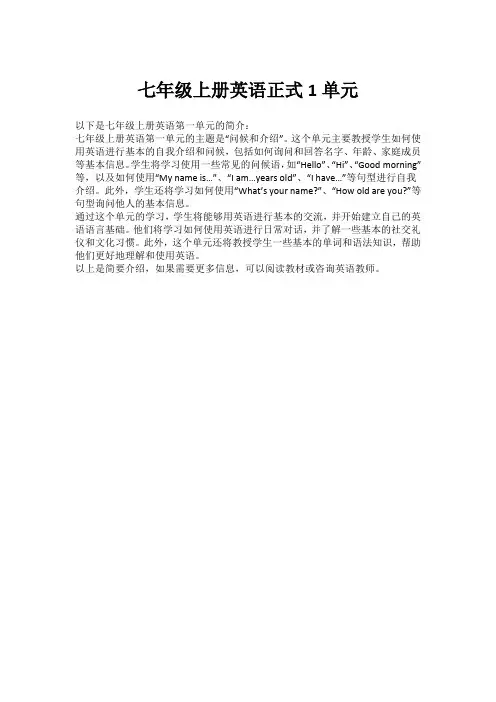
七年级上册英语正式1单元
以下是七年级上册英语第一单元的简介:
七年级上册英语第一单元的主题是“问候和介绍”。
这个单元主要教授学生如何使用英语进行基本的自我介绍和问候,包括如何询问和回答名字、年龄、家庭成员等基本信息。
学生将学习使用一些常见的问候语,如“Hello”、“Hi”、“Good morning”等,以及如何使用“My name is…”、“I am…years old”、“I have…”等句型进行自我介绍。
此外,学生还将学习如何使用“What’s your name?”、“How old are you?”等句型询问他人的基本信息。
通过这个单元的学习,学生将能够用英语进行基本的交流,并开始建立自己的英语语言基础。
他们将学习如何使用英语进行日常对话,并了解一些基本的社交礼仪和文化习惯。
此外,这个单元还将教授学生一些基本的单词和语法知识,帮助他们更好地理解和使用英语。
以上是简要介绍,如果需要更多信息,可以阅读教材或咨询英语教师。
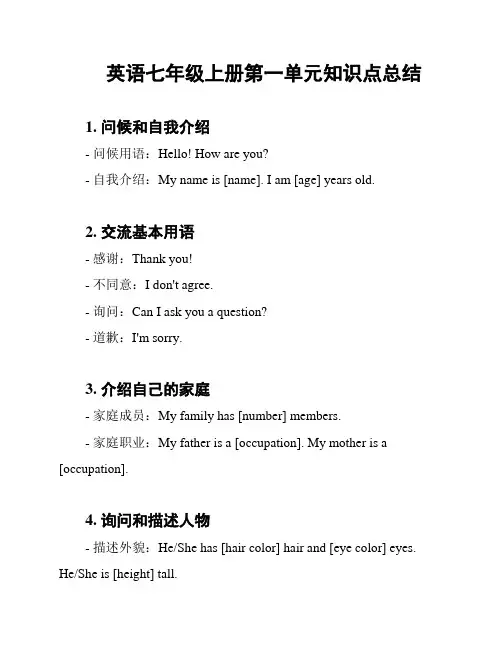
英语七年级上册第一单元知识点总结1. 问候和自我介绍- 问候用语:Hello! How are you?- 自我介绍:My name is [name]. I am [age] years old.2. 交流基本用语- 感谢:Thank you!- 不同意:I don't agree.- 询问:Can I ask you a question?- 道歉:I'm sorry.3. 介绍自己的家庭- 家庭成员:My family has [number] members.- 家庭职业:My father is a [occupation]. My mother is a [occupation].4. 询问和描述人物- 描述外貌:He/She has [hair color] hair and [eye color] eyes. He/She is [height] tall.- 描述个性:He/She is [personality trait], [personality trait], and [personality trait].5. 数字和年龄- 数字:0-10是 zero, one, two, three, four, five, six, seven, eight, nine, ten.- 年龄:I am [age] years old.6. 家庭及个人物品- 家庭物品:We have a [item] in our house.- 个人物品:I have a [item].7. 学校和课程- 学校:I go to [school name].- 课程:My favorite subject is [subject].8. 时间和日期- 星期:Monday, Tuesday, Wednesday, Thursday, Friday, Saturday, Sunday.- 日期:Today is [date].以上就是英语七年级上册第一单元的核心知识点总结。
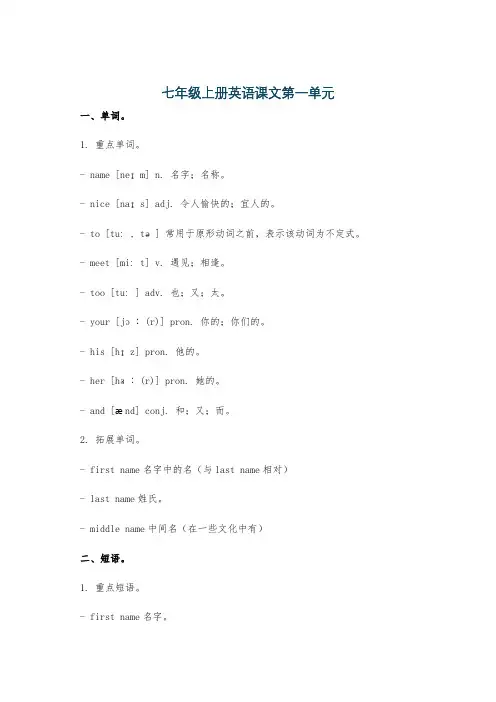
七年级上册英语课文第一单元一、单词。
1. 重点单词。
- name [neɪm] n. 名字;名称。
- nice [naɪs] adj. 令人愉快的;宜人的。
- to [tuː, tə] 常用于原形动词之前,表示该动词为不定式。
- meet [miːt] v. 遇见;相逢。
- too [tuː] adv. 也;又;太。
- your [jɔː(r)] pron. 你的;你们的。
- his [hɪz] pron. 他的。
- her [hɜː(r)] pron. 她的。
- and [ænd] conj. 和;又;而。
2. 拓展单词。
- first name名字中的名(与last name相对)- last name姓氏。
- middle name中间名(在一些文化中有)二、短语。
1. 重点短语。
- first name名字。
- last name姓氏。
- nice to meet you很高兴见到你(初次见面时的常用语)三、句型。
1. 重点句型。
- What's your name? 你叫什么名字?- My name's... 我的名字是……- Nice to meet you. 很高兴见到你。
- Nice to meet you, too. 我也很高兴见到你。
- His name's... 他的名字是……- Her name's... 她的名字是……2. 句型用法。
- “What's your name?”是用于询问对方名字的常用句型。
回答时可以用“My name is...”或者直接说名字。
例如:- A: What's your name?- B: My name is Tom.- “Nice to meet you.”用于初次见面时表达友好和礼貌。
当对方说“Nice to meet you.”时,我们通常回答“Nice to meet you, too.”例如:- A: Nice to meet you.- B: Nice to meet you, too.- 在描述他人名字时,我们可以用“His name's...”(指男性)或者“Her name's...”(指女性)。
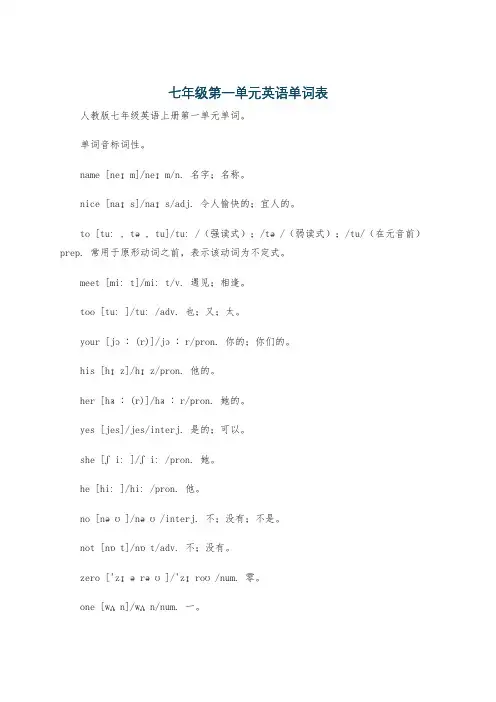
七年级第一单元英语单词表人教版七年级英语上册第一单元单词。
单词音标词性。
name [neɪm]/neɪm/n. 名字;名称。
nice [naɪs]/naɪs/adj. 令人愉快的;宜人的。
to [tuː, tə, tu]/tuː/(强读式);/tə/(弱读式);/tu/(在元音前)prep. 常用于原形动词之前,表示该动词为不定式。
meet [miːt]/miːt/v. 遇见;相逢。
too [tuː]/tuː/adv. 也;又;太。
your [jɔː(r)]/jɔːr/pron. 你的;你们的。
his [hɪz]/hɪz/pron. 他的。
her [hɜː(r)]/hɜːr/pron. 她的。
yes [jes]/jes/interj. 是的;可以。
she [ʃiː]/ʃiː/pron. 她。
he [hiː]/hiː/pron. 他。
no [nəʊ]/nəʊ/interj. 不;没有;不是。
not [nɒt]/nɒt/adv. 不;没有。
zero ['zɪərəʊ]/'zɪroʊ/num. 零。
one [wʌn]/wʌn/num. 一。
two [tuː]/tuː/num. 二。
three [θriː]/θriː/num. 三。
four [fɔː(r)]/fɔːr/num. 四。
five [faɪv]/faɪv/num. 五。
six [sɪks]/sɪks/num. 六。
seven ['sevən]/'sevən/num. 七。
eight [eɪt]/eɪt/num. 八。
nine [naɪn]/naɪn/num. 九。
telephone ['telɪfəʊn]/'telɪfoʊn/n. 电话;电话机。
number ['nʌmbə(r)]/'nʌmbər/n. 号码;数字。
phone [fəʊn]/foʊn/n. 电话;电话机(与telephone同义)it [ɪt]/ɪt/pron. 它。
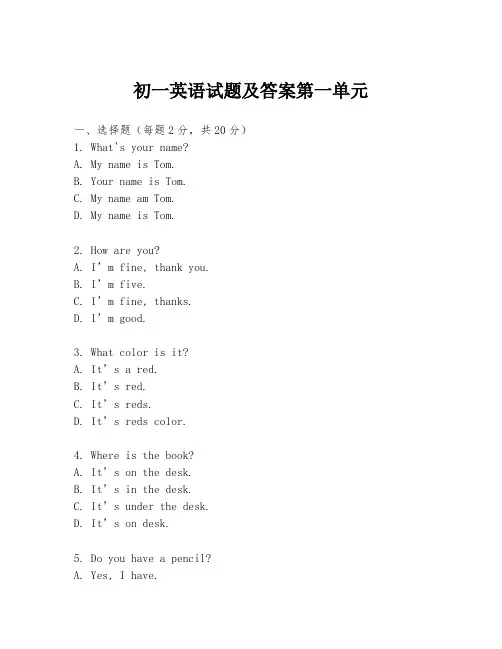
初一英语试题及答案第一单元一、选择题(每题2分,共20分)1. What's your name?A. My name is Tom.B. Your name is Tom.C. My name am Tom.D. My name is Tom.2. How are you?A. I’m fine, thank you.B. I’m five.C. I’m fine, thanks.D. I’m good.3. What color is it?A. It’s a red.B. It’s red.C. It’s reds.D. It’s reds color.4. Where is the book?A. It’s on the desk.B. It’s in the desk.C. It’s under the desk.D. It’s on desk.5. Do you have a pencil?A. Yes, I have.B. Yes, I do.C. No, I don’t have.D. No, I don’t.6. What time is it now?A. It’s nine o’clock.B. It’s at nine o’clock.C. It’s nine o’clocks.D. It’s on nine o’clock.7. Can you speak English?A. Yes, I can.B. Yes, I do.C. No, I can’t.D. No, I don’t.8. What’s your favorite subject?A. My favorite subject is math.B. My favorite subject are math.C. My favorite subject is maths.D. My favorite subject are maths.9. How many brothers do you have?A. I have two brothers.B. I have two brother.C. I have two brotherses.D. I have two brothers of.10. Let’s g o to the zoo.A. That sounds good.B. That sounds well.C. That sounds bad.D. That sounds badly.二、填空题(每空1分,共10分)11. My name is ________ (我).12. ________ (他) name is Jack.13. ________ (我们) are students.14. ________ (她) favorite color is blue.15. ________ (他们) are in the classroom.16. ________ (不) like apples.17. ________ (也) can play basketball.18. ________ (和) my sister, I like reading.19. ________ (但是) I don’t like math.20. ________ (因为) it’s too difficult.三、翻译题(每题3分,共15分)21. 你叫什么名字?A. What is your name?B. What are your name?C. What’s your name?D. What’s are your name?22. 你好吗?A. Are you good?B. Do you good?C. How are you?D. How do you?23. 这是你的书包吗?A. Is this your backpack?B. Is this you backpack?C. Is this your back pack?D. Is this you back pack?24. 我有一个哥哥和一个妹妹。
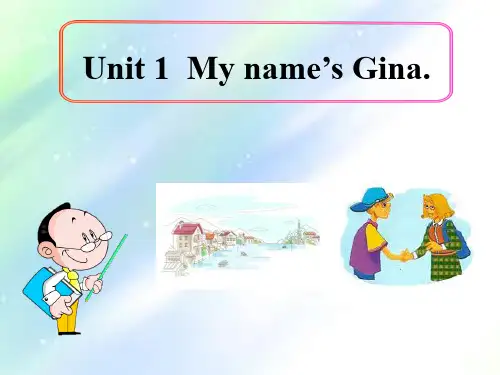
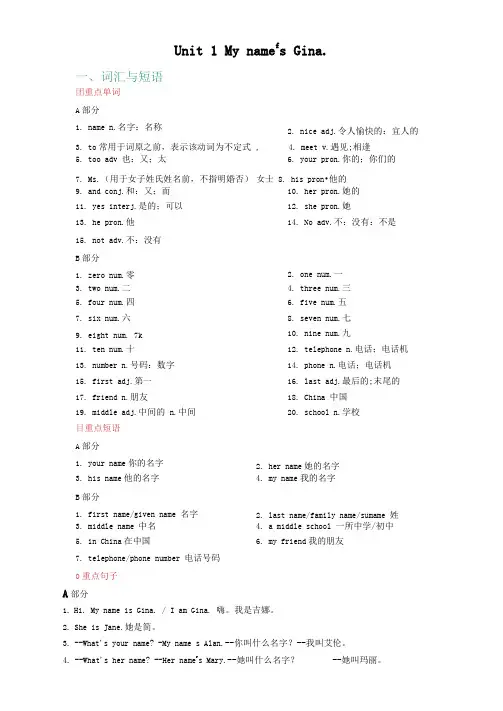
Unit 1 My name f s Gina.一、词汇与短语团重点单词A部分1. name n.名字:名称2. nice adj.令人愉快的:宜人的3. to常用于词原之前,表示该动词为不定式,4. meet v.遇见;相逢5. too adv 也:又;太6. your pron.你的;你们的7. Ms.(用于女子姓氏姓名前,不指明婚否)女士8. his pron•他的9. and conj.和:又;而10. her pron.她的11. yes interj.是的;可以12. she pron.她13. he pron.他14. No adv.不:没有:不是15. not adv.不:没有B部分1. zero num.零2. one num.一3. two num.二4. three num.三5. four num.四6. five num.五7. six num.六8. seven num.七9. eight num. 7k 10. nine num.九11. ten num.十12. telephone n.电话;电话机13. number n.号码:数字14. phone n.电话;电话机15. first adj.第一16. last adj.最后的;末尾的17. friend n.朋友18. China 中国19. middle adj.中间的n.中间20. school n.学校目重点短语A部分1. your name你的名字2. her name她的名字3. his name他的名字4. my name我的名字B部分1. first name/given name 名字2. last name/family name/sumame 姓3. middle name 中名4. a middle school 一所中学/初中5. in China在中国6. my friend我的朋友7. telephone/phone number 电话号码0重点句子A部分1.Hi. My name is Gina. / I am Gina. 嗨。
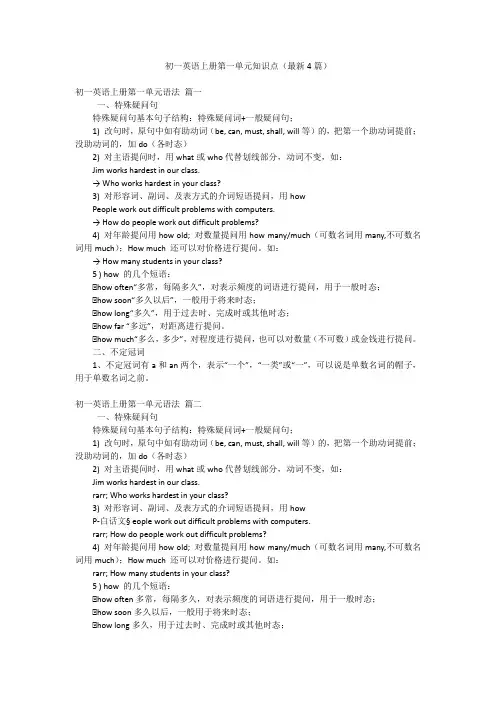
初一英语上册第一单元知识点(最新4篇)初一英语上册第一单元语法篇一一、特殊疑问句特殊疑问句基本句子结构:特殊疑问词+一般疑问句;1) 改句时,原句中如有助动词(be, can, must, shall, will等)的,把第一个助动词提前;没助动词的,加do(各时态)2) 对主语提问时,用what或who代替划线部分,动词不变,如:Jim works hardest in our class.→ Who works hardest in your class?3) 对形容词、副词、及表方式的介词短语提问,用howPeople work out difficult problems with computers.→ How do people work out difficult problems?4) 对年龄提问用how old; 对数量提问用how many/much(可数名词用many,不可数名词用much);How much 还可以对价格进行提问。
如:→ How many students in your class?5 ) how 的几个短语:◆how often“多常,每隔多久”,对表示频度的词语进行提问,用于一般时态;◆how soon“多久以后”,一般用于将来时态;◆how long“多久”,用于过去时、完成时或其他时态;◆how far “多远”,对距离进行提问。
◆how much“多么,多少”,对程度进行提问,也可以对数量(不可数)或金钱进行提问。
二、不定冠词1、不定冠词有a和an两个,表示“一个”,“一类”或“一”,可以说是单数名词的帽子,用于单数名词之前。
初一英语上册第一单元语法篇二一、特殊疑问句特殊疑问句基本句子结构:特殊疑问词+一般疑问句;1) 改句时,原句中如有助动词(be, can, must, shall, will等)的,把第一个助动词提前;没助动词的,加do(各时态)2) 对主语提问时,用what或who代替划线部分,动词不变,如:Jim works hardest in our class.rarr; Who works hardest in your class?3) 对形容词、副词、及表方式的介词短语提问,用howP-白话文§ eople work out difficult problems with computers.rarr; How do people work out difficult problems?4) 对年龄提问用how old; 对数量提问用how many/much(可数名词用many,不可数名词用much);How much 还可以对价格进行提问。
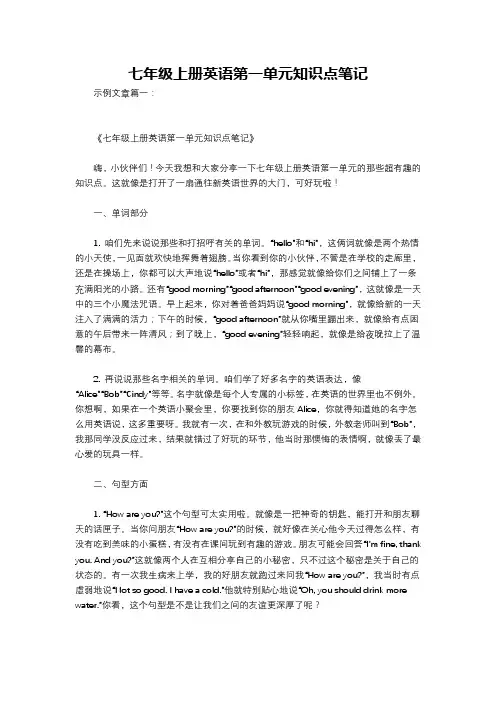
七年级上册英语第一单元知识点笔记示例文章篇一:《七年级上册英语第一单元知识点笔记》嗨,小伙伴们!今天我想和大家分享一下七年级上册英语第一单元的那些超有趣的知识点。
这就像是打开了一扇通往新英语世界的大门,可好玩啦!一、单词部分1. 咱们先来说说那些和打招呼有关的单词。
“hello”和“hi”,这俩词就像是两个热情的小天使,一见面就欢快地挥舞着翅膀。
当你看到你的小伙伴,不管是在学校的走廊里,还是在操场上,你都可以大声地说“hello”或者“hi”,那感觉就像给你们之间铺上了一条充满阳光的小路。
还有“good morning”“good afternoon”“good evening”,这就像是一天中的三个小魔法咒语。
早上起来,你对着爸爸妈妈说“good morning”,就像给新的一天注入了满满的活力;下午的时候,“good afternoon”就从你嘴里蹦出来,就像给有点困意的午后带来一阵清风;到了晚上,“good evening”轻轻响起,就像是给夜晚拉上了温馨的幕布。
2. 再说说那些名字相关的单词。
咱们学了好多名字的英语表达,像“Alice”“Bob”“Cindy”等等。
名字就像是每个人专属的小标签,在英语的世界里也不例外。
你想啊,如果在一个英语小聚会里,你要找到你的朋友Alice,你就得知道她的名字怎么用英语说,这多重要呀。
我就有一次,在和外教玩游戏的时候,外教老师叫到“Bob”,我那同学没反应过来,结果就错过了好玩的环节,他当时那懊悔的表情啊,就像丢了最心爱的玩具一样。
二、句型方面1. “How are you?”这个句型可太实用啦。
就像是一把神奇的钥匙,能打开和朋友聊天的话匣子。
当你问朋友“How are you?”的时候,就好像在关心他今天过得怎么样,有没有吃到美味的小蛋糕,有没有在课间玩到有趣的游戏。
朋友可能会回答“I'm fine, thank you. And you?”这就像两个人在互相分享自己的小秘密,只不过这个秘密是关于自己的状态的。
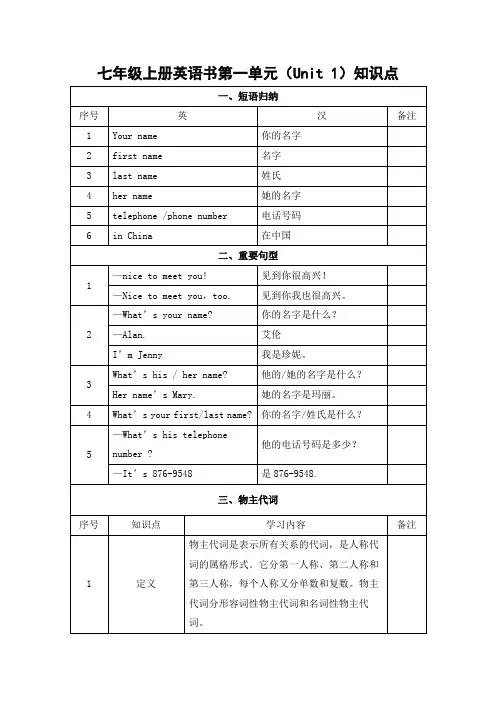
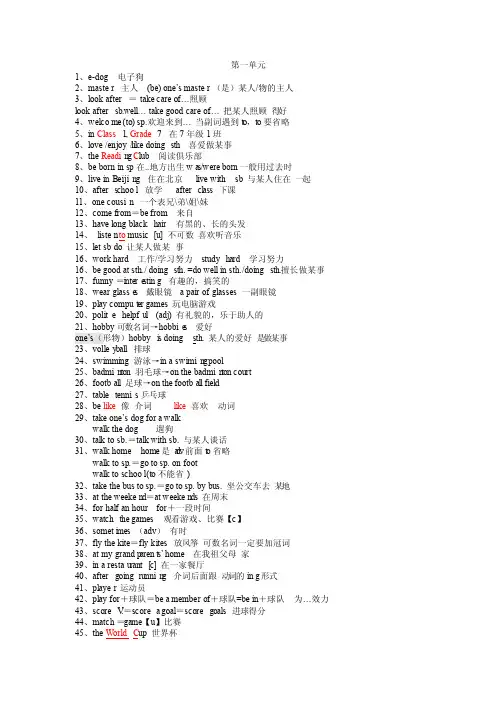
第一单元1、e-dog 电子狗2、master主人(be) one’s master(是)某人/物的主人3、look after=take care of…照顾look aftersb.well… take good care of…把某人照顾得好4、welcome (to) sp.欢迎来到…当副词遇到t o,to要省略5、in Class1, Grade7在7年级1班6、love /enjoy/like doingsth 喜爱做某事7、the Readin g C lub 阅读俱乐部8、be born in sp在..地方出生wa s/were born一般用过去时9、live in Beijin g住在北京live with sb 与某人住在一起10、after school放学after cl ass下课11、one cousin一个表兄\弟\姐\妹12、come from=be from 来自13、have long blackhair 有黑的、长的头发14、listen to music [u] 不可数喜欢听音乐15、let sb do 让某人做某事16、work hard 工作/学习努力studyhard 学习努力16、be good at sth./ doingsth. =do well in sth./doingsth.擅长做某事17、funny=i ntere sting有趣的,搞笑的18、wear glasse s 戴眼镜 a pair of glasse s 一副眼镜19、play comput er games玩电脑游戏20、polite helpfu l(adj) 有礼貌的,乐于助人的21、hobby可数名词→hobbie s 爱好one’s(形物)hobbyi s doingsth. 某人的爱好是做某事23、volley ball排球24、swimmi ng 游泳→in a swimin g pool25、badmin ton 羽毛球→on the badmin ton court26、football足球→on the footbal l field27、tabletennis乒乓球28、be like像介词like喜欢动词29、take one’s dog for a walkwalk the dog 遛狗30、talk to sb.=talk with sb. 与某人谈话31、walk home home是a d v前面t o省略walk to sp.=go to sp. on footwalk to school(to不能省)32、take the bus to sp.=go to sp. by bus. 坐公交车去某地33、at the weeken d=at weeken ds 在周末34、for half an hour for+一段时间35、watchthe games观看游戏、比赛【c】36、someti mes (adv)有时37、fly the kite=fly kites放风筝可数名词一定要加冠词38、at my grandp arent s’ home 在我祖父母家39、in a restau rant [c] 在一家餐厅40、aftergoing runnin g介词后面跟动词的ing形式41、player 运动员42、play for+球队=be a member of+球队=be in+球队为…效力43、scoreV.=score a goal=scoregoals进球得分44、match=game【u】比赛45、the WorldC up 世界杯46、one's (形物) favouri te sth. is…=sb like sth best某人最喜欢的...是…47、sports news 【u】体育新闻48、the newest member最新的成员49、birthp lace出生地50、look+adj 系动词看上去....样51、win again再次赢得比赛52、borrow 借进borrow sth from sb. 从某人那里借来某物lend 借出lend sth. to sb. 把某物借给某人53、How do you say sth. in English?=What's this/that in Englis h? 用英语怎么说?54、understardV. 理解,明白55、the answer to sth. ......的答案the answer to the questi on问题的答案56、all your friend s 全部,所有adv 都(两者以上)57、all come from=be all from 都来自58、different Clubs不同的俱乐部59、Soundgreat adj听起来不错60、Fish [u] 鱼肉、种类、条数61、be helpfu l to sb. 对某人怎么样be nice to do sb.be friendl y to sb.62、begin/start to do/doingsth 开始做某事63、Want to do sth. =wouldlike to do 想要做某事64、all one's(形物) sth. 某人所有的东西65、this pair of glasse sthis pair of trouse rs 动词看pai r的单复数67、使用一般现在时的情况:(1)目前真实存在的事(2)定期经常做的事(3)客观永远存在的事实真理或科学规律68、实义动词/行为→表示动作或行为的词,有实在的意义。
人教版七年级上册初一上册英语第一单元优质课件一、教学内容本节课,我们将在人教版七年级上册英语第一单元展开学习。
具体内容包括:Unit 1 My name is Gina. 我们将重点学习section A 1a2d,掌握如何用英语进行自我介绍,询问和回答姓名、国籍等基本交际用语。
二、教学目标1. 让学生掌握本节课重点单词和短语,如name, last name, first name, China, class, grade等。
2. 培养学生运用所学知识进行自我介绍和询问他人姓名能力。
3. 提高学生听说能力,使他们能够在实际情景中运用所学知识进行交流。
三、教学难点与重点1. 教学难点:正确使用last name和first name,以及名词单复数变化。
2. 教学重点:自我介绍和询问他人姓名表达方式。
四、教具与学具准备1. 教具:多媒体课件、黑板、磁带等。
2. 学具:课本、练习本、彩色笔等。
五、教学过程1. 导入:通过播放一首英文歌曲《Hello, hello, hello》,让学生感受英语氛围,同时引出本节课主题——自我介绍。
2. 新课内容展示:a. 播放section A 1a录音,让学生跟读,学习如何用英语进行自我介绍。
b. 展示section A 2a图片,引导学生学习如何询问和回答姓名。
c. 通过小组合作,让学生练习自我介绍和询问他人姓名交际用语。
3. 例题讲解:a. 解析section A 2b对话,讲解如何询问和回答国籍。
b. 分析section A 2c练习,引导学生正确使用last name和first name。
4. 随堂练习:a. 让学生模仿section A 2a2c内容,进行自我介绍和询问他人姓名练习。
b. 教师随机抽取学生进行角色扮演,检验学生对所学知识掌握。
b. 学生分享学习心得,互相交流。
六、板书设计1. Unit 1 My name is Gina.2. 重点单词和短语:name, last name, first name, China, class, grade等。
初一英语上册第一单元通常围绕自我介绍、家庭成员、日常活动等主题展开。
以下是一些常见的知识点归纳:1. 自我介绍:- My name is...(我的名字是...)- I am... years old.(我...岁。
)- I come from...(我来自...)- I have... brothers/sisters.(我有...个兄弟姐妹。
)2. 家庭成员:- father, mother, brother, sister(父亲,母亲,兄弟,姐妹)- family(家庭)- There are... people in my family.(我家有...个人。
)3. 日常活动:- I go to school by...(我通过...去上学。
)- I like to play...(我喜欢玩...)- I have lunch at...(我在...吃午饭。
)4. 常见疑问词:- What is your name?(你叫什么名字?)- How old are you?(你多大了?)- Where do you come from?(你来自哪里?)-How many brothers/sisters do you have?(你有多少兄弟姐妹?)5. 常用动词:- be(am, is, are)(是)- have(有)- come from(来自)- go to(去)6. 基本句型:- My name is...(我的名字是...)- I am... years old.(我...岁。
)- I come from...(我来自...)- I have... brothers/sisters.(我有...个兄弟姐妹。
)- I go to school by...(我通过...去上学。
)- I like to play...(我喜欢玩...)- I have lunch at...(我在...吃午饭。
初一上册英语第一单元知识点及考点题目讲解重点单词、短语name /neim/ n. 名字;名称nice /nais/ adj. 令人愉快的;宜人的to /tu:/ 常用于原形动词之前,表示该动词为不定式meet /mi:t/ v. 遇见;相逢too /tu:/ adv. 也;又;太your /jɔ:/ pron. 你的;你们的Ms. /miz/ (用于女子的姓氏或姓名前,不指明婚否)女士his /hiz/ pron. 他的and /ænd/ conj. 和;又;而her /hə:/ pron, 她的yes /jes/ interj. 是的;可以she /ʃi:/ pron. 她he /hi:/ pron. 他no /nəu/ interj. 不;没有;不是not /nɔt/ adv. 不;没有zero /'ziərəu/ num. 零one /wʌn/ num. 一two /tu:/ num. 二three /θri:/ num.三four /fɔ:/ num. 四five /faiv/ num. 五six /siks/ num. 六seven /'sevn/ num. 七eight /eit/ num. 八nine /nain/ num. 九telephone /'telifəun/n. 电话;电话机number /'nʌmbə/ n. 号码;数字phone /fəun/ n. 电话;电话机telephone/phone number电话号码first /fə:st/ adj. 第一first name 名字last /la:st/ adj. 最后的;末尾的last name 姓friend /frend/ n. 朋友China /'tʃainə/ 中国middle /'midl/ adj. 中间的;中间school /sku:l/ n. 学校middle school 中学;初中Gina 吉娜(女名)Jenny 珍妮(女名)Brown 布朗(姓)Alan 艾伦(男名)Tom 汤姆(男名)Mike 迈克(男名)Jack 杰克(男名)Mary 玛丽(女名)Miller 米勒(姓)Linda 琳达(女名)Jane 简(女名)Green 格林(姓)Smith 史密斯(姓)1.my name我的名字2.your name 你的名字3.her name 她的名字.4.his name 他的名字5.I’m .. .我是……6.first name 名字st name/family name 姓氏8.Ms. Brown 布朗女士9.your school ID card 你的学生卡10.phone/telephone number 电话号码11.his ID card number 他的身份证号码12.my friend 我的朋友13.nice to meet you 很高兴见到你14.middle school 中学15. in China 在中国重点句型或语法一、重点句型1. — What’s your name? 你叫什么名字?一I’m /M y name is Alan. 我叫艾伦。
七年级英语unit1
在七年级英语中,Unit 1 通常包含以下几个主要内容:
1. 自我介绍:这是单元的开篇部分,重点让学生能够用英语进行简单的自我介绍,包括介绍自己的名字、年龄、喜好等信息。
2. 基础语法:在这个单元中,学生将学习到一些基础的语法知识,如名词、动词、形容词等的基本用法。
3. 日常对话:学生将学习如何用英语进行日常的简单对话,例如问候、谈论天气、介绍家庭成员等。
4. 阅读理解:学生将通过阅读短文来提高阅读理解能力,这些短文通常与学生的日常生活相关。
5. 写作练习:学生将练习写简单的英语短文,例如日记或电子邮件。
6. 词汇和短语:这个单元会介绍一些新的词汇和短语,帮助学生扩大词汇量。
7. 文化知识:在学习过程中,学生也会接触到一些与英语国家相关的文化知识,例如节日、食物、传统等。
具体的课程内容可能会因教材和教学大纲的不同而有所差异。
为了获取最准确和全面的信息,建议查阅所用教材的目录或与英语教师进行沟通。
七年级上册英语第一单元笔记总结归纳The first unit of the seventh grade English textbook mainly focuses on introducing oneself, talking about daily routines, describing physical appearance, and discussing hobbies and interests.In the first part, we learned how to introduce oneself, including name, age, and nationality. We also practiced asking and answering questions about where we come from and what we like to do.The second part of the unit covered daily routines. We learned how to talk about our daily activities using present simple tense, such as "I get up at 7 o'clock" or "I brush my teeth before breakfast."The third part was about describing physical appearance. We learned adjectives to describe people's appearance, such as tall, short, thin, and fat. We also practiced asking andanswering questions about physical appearance, such as "What does she look like?"In the last part of the unit, we talked about hobbies and interests. We learned how to talk about the activities we enjoy, such as "I like playing basketball" or "My hobby is reading books."Overall, this unit provided a good foundation for introducing ourselves, talking about daily routines, describing physical appearance, and discussing hobbies and interests. We practiced speaking and writing about these topics, and I feel more confident in using English to communicate about these everyday aspects of life.。